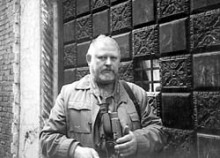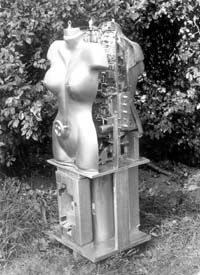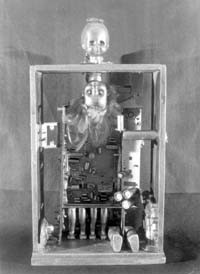One can be born with an artist’s talent, but then find oneself in any walk of life. One can take up any profession, but that talent will make one constantly perceive the surrounding realities creatively, striving to make them better, and adding an aesthetic touch, leading them to harmonious perfection. Being an artist means a constant painstaking search for harmony in the environment, an incessant attempt to change it, make it better and more attractive. Only great artists come up with great discoveries, inventing new techniques, recipes, mechanisms, and creative solutions. Only such artists can reveal, decipher, define, formulate, and portray something in a manner producing the only correct and harmonious result. These artists are called upon to perfect everything they come across: objects, the environment, and society. When I say great artists, I mean not only Leonardo da Vinci, Michelangelo, Rembrandt, or Rodin, but also Wiener, Einstein, Newton, Edison, and Count Stroganov. Einstein pointed out that a formula is correct because it is beautiful.
The art gallery Lavra hosted a display of new prints, canvases, and metal-plastic sculptures by precisely one such creative personality, Oleksandr Mylovzorov.
A graduate of the Soviet Union’s most prestigious Mukhina Higher School of the Arts in Leningrad, he concentrated on ceramics, glass, and metals for a number of years. He took part in the creation of interiors, “small architectural forms,” plastic and monumental compositions, small plastic works and wrought metal. Mylovzorov amazed colleagues with sudden and unusual solutions and techniques.
Over the past several years he has also paid attention to traditional trends, pictorial and graphic art, lending them his innate dynamism, his vision of new color and forming reflections.
This time his audiences, accustomed to Mylovzorov’s unbridled, pointless fantasies, saw a balanced classical approach, even though some of the works brimmed with expressive emotional permissiveness.
The exposition was titled “The Golden Age. Reflections” and consisted of three types of works: paintings, prints, and plastic compositions. All this could be described as a symbolic plastic collage. Whereas the first two types were kept in the traditional style, the plastic group was in sharp contrast, in terms of components used by the author to achieve vivid solutions.
Oleksandr Mylovzorov is a man of keen intellect and matching vision. He can sort through a dump heap of household utensils or industrial objects and come up with an item outwardly useless. But it acquires its own special aesthetic value when singled out from the general unattractive background of our daily life. It becomes a thing in itself, having indisputable artistic and semantic qualities. Previously this was what happened to one of Mylovzorov’s know-how using rusty sheets of roofing iron as a picturesque background. This time he presented compositions using old TV and PC circuits combined with dismembered dolls, producing plastic objects symbolizing today’s social attitudes dominated by confusion, self-assurance, mechanically simplified consciousness beating about the Internet and kitsch.
Yet this is not the greatest value of Mylovzorov’s works on display. What makes them so vividly distinct from countless other expositions is that, even if using various techniques and artistic solutions, all the images are united by a single powerful — energetic if you will — thrust, tremendous vitality, and an incessant optimistic thirst for life. All of his works are distinguished by a rich colorful style, bold and easy strokes and easy delicate lines. Not a single one betrays caution, hesitation or restraint. And nor is it coincidental that the antique theme is present in practically every painting and print.
In fact, plastic objects sprayed with golden paint create a certain emotional atmosphere which makes them monumental and harmonious, akin to antique sculptures.
What can be more life-asserting than the art of Old Greece with its love of life, joy, and impetuous spontaneous happiness? Only the self- confident Greeks could afford to make the most of their life, without doubts, never looking back. Only a great people could produce famous scholars, philosophers, poets, and artists. Only a great people could afford to have gods making love to mortal women and giving birth to heroes. Only an individual experiencing the joy of being in existence can follow in their ancestors’ footsteps. The author of the exposition seems to tell his visitors, “Stop sniveling and dwelling on your own sewage, complaining of hemorrhoids, gout, and indigestion. Take a look around. Life is beautiful! There are so many gorgeous women and handsome, strong men that are generally not bad at all. Have some wine, make love, and be happy.” In his works numerous gods, centaurs, angels, cupids, naiads, you name it, are merry-making, dancing, boozing, playing zithers and harps, caught in the merry-go-round of a joyous bacchanalia. They are free and happy. So much so that the viewer, regardless of his own mood, age, even sex, begins to feel easier and freer.
Even when the author resorts to the good old technique of a rusty iron roof serving as a background (seriously, not looking very cheerful) with an open color of spots combined with bright rich tones of simplified geometrical figures and golden integrated circuits playing with light reflections, one is left with the impression of colorful purity and a child’s sincerity.
Ars longa... The adage dates back hundreds of years. Indeed, art lives forever and I would add that it has countless manifestations, but always implies adequate perception. Otherwise the author can hardly expect to be understood and appreciated. You can’t expect a cat marvel at a canary. It’s just food for her, meaning that she must grab, kill, and eat the bird. Likewise, when the author undertakes a subject or applies a certain technique, he must think over the language he will use, so the audience can understand him.
Oleksandr Mylovzorov is very good at this, better than many colleagues. His prints dealing with antique themes reflect his knowledge of techniques and styles of that distant period. Some are done using a broad-brush stroke, as in Old Greek vases, others imitate graffiti — in this case linear images delicately chiseled on ceramic pieces or walls. They are laconic, consist of one or two main characters, and their compositional unity is maintained with the aid of a number of accessories and details, be it a section of an amphora, a hand holding a flute, an ornament, or a miniature cupid or centaur.
At the same time, his paintings are multi figure compositions executed with dynamic broad-brush strokes. The figures are intertwined in a complex dancing-carnival pattern. Their oval and plastic forms make these figures unpretentious and friendly. Although the details are not elaborated and the plot is guessed only through the action and accessories, the mood and emotional emphasis are easily perceived through the color pattern. It is possible because there are practically no dark tones in his pictures and the images are built using single strokes of light pastel blue, yellow and green.
In the works on display in Kyiv, Oleksandr Mylovzorov skillfully combines a subjectless approach with vivid solutions. By using unobtrusive mosaic components made up of shapeless color spots as a backdrop for human figures, the artist achieves a degree of monumentality and the overall impression is that of ancient fresco decorations done in situ.
The exposition proved a great success, featuring creations by a man who loves and can make the most of his life. It is a tribute to a distinguished artist with a strong will and tremendous zest for life. After exploring it you find yourself hoping that not everything has been lost, sold or squandered on drink in this abysmally brutal world; that there could be a better future.









